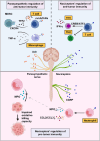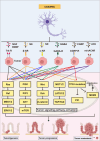Integrating neuroscience and oncology: neuroimmune crosstalk in the initiation and progression of digestive system tumors
- PMID: 40784897
- PMCID: PMC12337452
- DOI: 10.1186/s12943-025-02412-9
Integrating neuroscience and oncology: neuroimmune crosstalk in the initiation and progression of digestive system tumors
Abstract
Recent global data show that cancers of the digestive system are responsible for approximately one-third of all cancer-related deaths worldwide, underscoring the urgent need for innovative therapeutic strategies. In this context, emerging findings from neuroscience may unveil new avenues for tackling this pressing clinical problem. Over the past few years, rapid progress in cancer neuroscience has increasingly underscored the contribution of the nervous system to the development and progression of digestive tract tumors. Research has shown that the specialized neural network of the gastrointestinal tract establishes a framework for reciprocal interactions with digestive tract tumors. On this anatomical foundation, our review delves into the functional significance of these interactions, emphasizing the bidirectional regulatory pathways between the nervous system and tumor cells during disease progression and highlighting their intricate crosstalk with the immune microenvironment. In particular, it maps the molecular pathways by which both the central and peripheral nervous systems (PNS) modulate tumor initiation and progression. Moreover, it explains how neurotransmitters and neuroendocrine mediators drive tumor expansion through the activation of canonical oncogenic signaling cascades and the remodeling of the immunosuppressive microenvironment. This review seeks to elucidate the molecular underpinnings of neuro-immune-tumor crosstalk and to synthesize the latest neural-targeted therapeutic approaches. It also examines the principal obstacles that are impeding the clinical implementation of these interventions. By presenting an integrated overview, this work serves as a robust resource to inform future studies on neurobiological mechanisms and the development of novel therapies for gastrointestinal malignancies.
Keywords: Cancer neuroscience; Digestive system tumors; Neuro-targeted therapy; Neuroendocrine mediators; Neuroimmune crosstalk; Tumor microenvironment.
Conflict of interest statement
Declarations. Ethics approval and consent to participate: Not applicable. Consent for publication: Not applicable. Competing interests: The authors declare no competing interests. Generative AI and AI-assisted technologies in the writing process: There is no generative AI and AI-assisted technologies applied in the whole process of writing.
Figures






Similar articles
-
The Case for Neurosurgical Intervention in Cancer Neuroscience.Neurosurgery. 2025 Jan 1;96(1):10-17. doi: 10.1227/neu.0000000000003039. Epub 2024 Jun 21. Neurosurgery. 2025. PMID: 38904388 Free PMC article. Review.
-
The Role of the Tumor Microenvironment in Gastroenteropancreatic Neuroendocrine Tumors.Int J Mol Sci. 2025 Jun 12;26(12):5635. doi: 10.3390/ijms26125635. Int J Mol Sci. 2025. PMID: 40565098 Free PMC article. Review.
-
Clinical and biological heterogeneity of Grade 2 digestive neuroendocrine neoplasms: prognostic significance of the 10% Ki-67 index cutoff and implications for treatment strategies. A longitudinal study.J Endocrinol Invest. 2025 Jun;48(6):1483-1493. doi: 10.1007/s40618-025-02552-1. Epub 2025 Feb 19. J Endocrinol Invest. 2025. PMID: 39969798
-
Impact of gastrointestinal dysbiosis on tryptophan metabolism and neurological cancer progression.Med Oncol. 2025 Aug 6;42(9):412. doi: 10.1007/s12032-025-02972-2. Med Oncol. 2025. PMID: 40770583 Review.
-
Patterns, clinical presentations, and time to diagnosis in pediatric central nervous system tumors: insights from a pediatric neuro-oncology tumor board team at a tertiary referral hospital in Ethiopia.J Neurooncol. 2025 Sep;174(3):587-598. doi: 10.1007/s11060-025-05040-x. Epub 2025 Jun 13. J Neurooncol. 2025. PMID: 40512283
References
-
- Bray F, Laversanne M, Sung H, Ferlay J, Siegel RL, Soerjomataram I, et al. Global cancer statistics 2022: GLOBOCAN estimates of incidence and mortality worldwide for 36 cancers in 185 countries. CA Cancer J Clin. 2024;74:229–63. - PubMed
-
- Rutledge A, Jobling P, Walker MM, Denham JW, Hondermarck H. Spinal cord injuries and nerve dependence in prostate Cancer. Trends Cancer. 2017;3:812–5. - PubMed
Publication types
LinkOut - more resources
Full Text Sources
Miscellaneous

